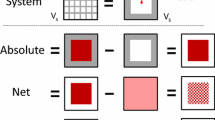Abstract
The character of distribution of electron density over the proximity of a halide anion specifically adsorbed at the s,p-metal-electrolyte solution interface boundary was considered. An assumption was made that the physical nature of the specific bonding of the anion is caused by mixing of electron waves of free electrons in the metal and the valent state of the anion as the electrons resonantly overcome the potential barrier between the anion and the metal. The physical (dissipative quantum) mechanism of microscopic processes is described using the Anderson impurity model, the Friedel sum rule, and the Parr conception of equalization of electronegativity values that determine the partial transfer of electron charge from the anion to the metal and the emergence of localized dipole at the interphase boundary. The equations renormalizing the microscopic parameters of the adsorption event to macroscopic state functions of the adsorption phase on an electrode were obtained. The chemical potential of the halide anion specifically adsorbed from electrolyte solution on an uncharged electrode is estimated. The mechanism under consideration explains the details of the dependences of polarization parameters of the electrode on anion and metal nature.
Similar content being viewed by others
References
Frumkin, A.N., Potentsialy nulevogo zaryada (Potentials of Zero Charge), Moscow: Nauka, 1982.
Marnin, Th., Bruinsma, R., and Platsman, P.M., Phys. Rep., 1993, vol. 223, p. 135.
Lang, N.D., Phys. Rev. Lett., 1981, vol. 46, p. 842.
Gabovich, A.M., Reznikov, Yu.A., and Voitenko, A.I., Phys. Rev. E, 2006, vol. 73. p. 021606.
Kuklin, R.N., Elektrokhimiya, 1977, vol. 13, p. 1182.
Vorotyntsev, M.A. and Kornyshev, A.A., Elektrostatika sred s prostranstvennoi dispersiei (Electrostatics of Media with the Spatial Dispersion), Moscow: Nauka, 1993.
Gurney, R., Phys. Rev., 1935, vol. 45, p. 479.
Grimley, T.B., Proc. Phys. Soc., 1967, vol. 90, p. 751.
Bennett, A.J. and Falicov, L.M., Phys. Rev., 1966, vol. 151, p. 512.
Lorenz, W. and Salie, G., Z. Phys. Chem., 1961, vol. 218, p. 259.
Schultze, J.W. and Vetter, K.J., J. Electroanal. Chem., 1973, vol. 44, p. 63.
Koppitz, F.D., Schultze, J.W., and Rolle, D., J. Electroanal. Chem., 1984, vol. 170, p. 5.
Parr, R.G. and Yang, W., Density Functional Theory of Atoms and Molecules, New York: Oxford Univ. Press, 1989.
Newns, D.M., Phys. Rev., 1969, vol. 178, p. 1123.
Kuklin, R.N., Elektrokhimiya, 1979, vol. 15, p. 1763.
Landau L.D., Lifshits E.M., Kvantovaya mekhanika. Nerelyativistskaya teoriya (Quantum Mechanics. Nonrelativistic Theory), Moscow: Nauka, 1989.
Volokitin, A.I., Fiz. Tverd. Tela, 1978, vol. 20, p. 1206.
Medvedev, I.G., Khim. Fiz., 1985, vol. 4, p. 103.
Davydov, S.Yu. and Troshin, S.V., Phys. Solid State, 2007, vol. 49, p. 1583.
Migdal, A.B., Kachestvennye metody v kvantovoi teorii (Qualitative Methods in Quantum Theory), Moscow: Nauka, 1975.
Fukui, K., Yonezawa, T., and Shingu, H., J. Chem. Phys., 1952, vol. 20, p. 722.
Ziman, J., Principles of the Theory of Solids, Cambridge, Mass.: Cambridge Univ. Press, 1972.
Langer, J.S. and Ambegaokar, V., Phys. Rev., 1961, vol. 121, p. 1090.
Friedel, J., Philos. Mag., 1952, vol. 43, p. 153.
Langer, J.S., Phys. Rev., 1966, vol. 150, p. 516.
Muscat, J.P. and Newns, D.M., J. Phys. C: Solid State Phys., 1974, vol. 7, p. 2630.
Ashcroft, N. and Mermin, N., Solid State Physics, New York: Holt, Rinehart, and Winston, 1976.
Kratkii spravochnik fiziko-khimicheskikh velichin (Brief Handbook on Physicochemical Values), Mishchenko, K.P. and Ravdel’, A.A, Eds., Moscow: Goskhimizdat, 1974.
Grahame, D.C., J. Am. Chem. Soc., 1954, vol. 76, p. 4819.
Kuklin, R.N. and Emets, V.V., Prot. Met. Phys. Chem. Surf., 2012, vol. 48, no. 4, p. 406.
Kuklin, R.N., Elektrokhimiya, 1979, vol. 15, p. 1763.
Kuklin, R.N., Elektrokhimiya, 1982, vol. 18, p. 1526.
Kuklin, R.N. and Emets, V.V., Russ. J. Phys. Chem. B, 2009, vol. 3, p. 818.
Kuklin, R.N., Inform.-Analit. Zh., 2008, no. 6, p. 131.
Author information
Authors and Affiliations
Corresponding author
Additional information
Original Russian Text © R.N. Kuklin, V.V. Emets, 2014, published in Fizikokhimiya Poverkhnosti i Zashchita Materialov, 2014, Vol. 50, No. 1, pp. 8–18.
Rights and permissions
About this article
Cite this article
Kuklin, R.N., Emets, V.V. Form factor of the electron density of an anion specifically adsorbed on metal surface in an electrolyte. Prot Met Phys Chem Surf 50, 5–14 (2014). https://doi.org/10.1134/S2070205114010079
Received:
Published:
Issue Date:
DOI: https://doi.org/10.1134/S2070205114010079




